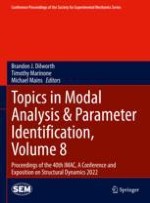2023 | Buch
Topics in Modal Analysis & Parameter Identification, Volume 8
Proceedings of the 40th IMAC, A Conference and Exposition on Structural Dynamics 2022
herausgegeben von: Dr. Brandon J. Dilworth, Timothy Marinone, Assoc. Prof. Michael Mains
Verlag: Springer International Publishing
Buchreihe : Conference Proceedings of the Society for Experimental Mechanics Series
